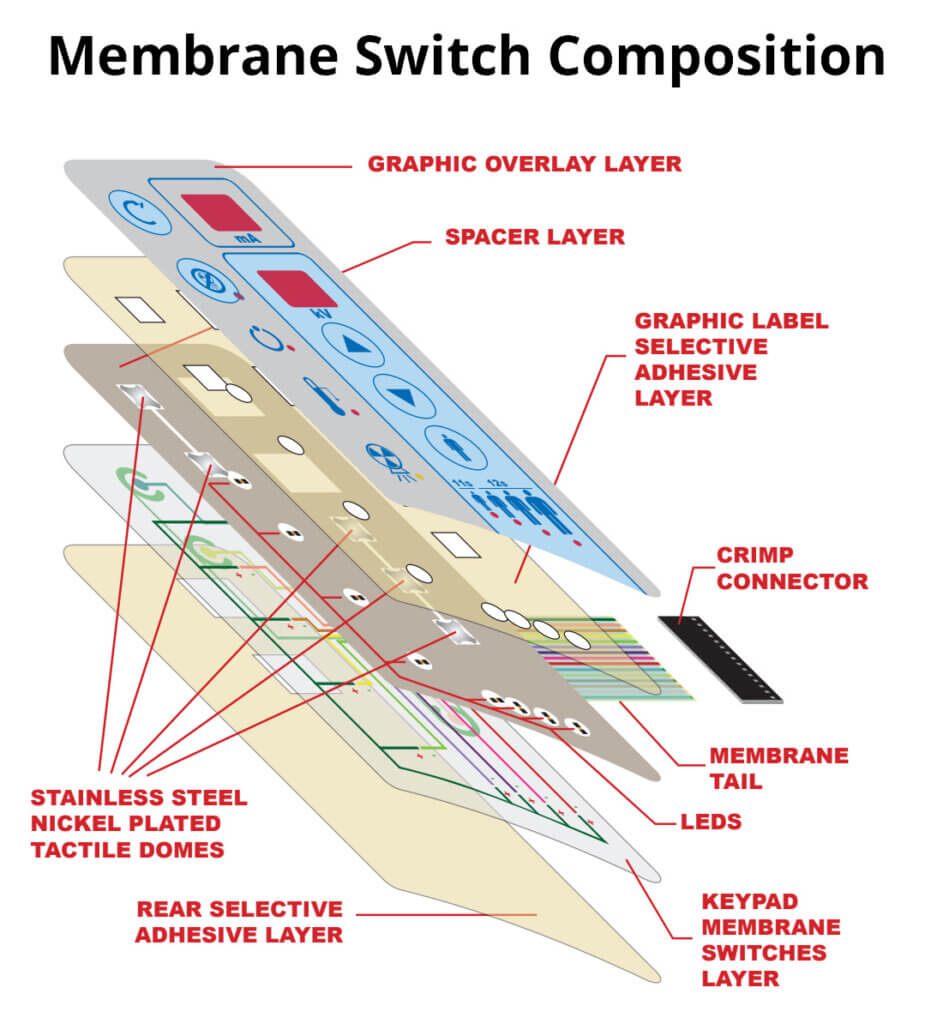Recognizing Membrane Switches: The Key to Reputable and sturdy Controls

What Are Membrane Layer Switches?
Membrane switches are an advanced remedy in the world of interface technology, incorporating functionality and style perfectly. These tools work as a user interface between individuals and digital systems, incorporating several parts right into a small format. Normally created from flexible, slim layers of products, membrane layer buttons are made to respond to touch, allowing individuals to interact with machinery and electronic tools effectively.
The primary elements of a membrane button include a printed circuit layer, visuals overlay, and a spacer layer that avoids unintended activation. The visuals overlay can be customized to show brand name identity or individual preferences, boosting aesthetic appeals while guaranteeing functionality. Membrane layer switches are typically utilized in different applications, consisting of medical tools, customer electronics, and industrial devices, owing to their resilience and resistance to ecological aspects such as dampness and dirt.
Among the vital advantages of membrane switches is their capability to hold up against deterioration, making them suitable for high-traffic environments. Furthermore, they are light-weight and need very little room, enabling cutting-edge styles in product advancement. On the whole, membrane layer switches over stand for a effective and useful selection for modern electronic interfaces, weding modern technology with user-centric design principles.
Exactly How Membrane Layer Switches Work
The operation of membrane changes hinges on a basic yet reliable mechanism that translates user input into digital signals. When a user presses the button, the leading layer deforms, enabling a conductive aspect in the circuit layer to make contact with an equivalent conductive pad on the underside of the visuals overlay.
The design of membrane buttons can differ, however they often incorporate domes or responsive components to give comments to the customer, enhancing the total experience - membrane switch. The materials used in membrane layer switches, such as polyester or polycarbonate, add to their durability and resistance to environmental elements, including dampness and dirt. The printed circuits are typically enveloped, which protects them from wear and tear over visit this page time.
Advantages of Membrane Buttons

Additionally, membrane switches are understood for their sturdiness. Created from durable materials, they are resistant to dirt, dampness, and physical wear, which considerably prolongs their life expectancy contrasted to typical mechanical buttons. This sturdiness makes them especially suitable for high-traffic settings and applications requiring longevity.
One more significant benefit is the ease of cleansing and upkeep. The smooth surface area of membrane layer changes decreases dirt buildup and is frequently unsusceptible spills, making them perfect for settings that need constant sanitization.
Furthermore, membrane buttons supply a structured account, causing a thinner layout that can be incorporated right into numerous gadgets without including bulk. This function not only improves the visual appeal however additionally contributes to a more ergonomic item layout.
Applications of Membrane Layer Switches
User-friendly and versatile, membrane buttons discover applications throughout a large range of markets, consisting of clinical gadgets, consumer electronic devices, and industrial equipment. In the medical field, these switches are essential to gadgets such as analysis devices, client surveillance look at here systems, and infusion pumps, where reliability and convenience of cleansing are important. Their capability to withstand extreme atmospheres and preserve functionality makes them perfect for such applications.

In customer electronics, membrane switches are made use of in products like microwaves, washing machines, and push-button controls - membrane switch. Their sleek layout enables user-friendly interface, improving the general user experience while giving resilience and resistance to tear and wear
Industrial tools additionally profits from membrane switches, especially in control panels for machinery and automation systems. These buttons provide security versus dust and wetness, guaranteeing consistent efficiency in tough environments. Their personalized attributes allow producers to customize them to particular operational requirements, improving effectiveness and capability.
Selecting the Right Membrane Change
When selecting a membrane layer button, it is essential to think about different variables that affect performance and suitability for particular applications. The main factors to consider include ecological conditions, responsive comments, resilience, and style specifications.
First, analyze the operating atmosphere; buttons subjected to moisture, chemicals, or severe temperatures call for specific products to guarantee long life and capability. Next off, assess the demand for tactile feedback. Depending on user interaction, some applications might take advantage of a tactile action to validate activation, while others might like a non-tactile design for aesthetic factors.
Sturdiness is another important aspect; membrane switches should look these up be developed to endure frequent usage, impacts, and abrasion. Make certain the selected button can withstand the anticipated lifecycle, particularly in high-usage situations.

Verdict
In verdict, membrane layer switches serve as crucial elements in the layout of reliable and resilient control systems throughout numerous markets. The adaptability of membrane switches over enables for tailored remedies that satisfy specific operational demands, reinforcing their value in modern innovation.
Membrane layer switches over represent a critical aspect of contemporary user interface style, blending functionality with durability in different applications.Membrane layer switches are a sophisticated solution in the realm of customer interface technology, incorporating functionality and layout effortlessly. Commonly created from adaptable, thin layers of products, membrane layer buttons are designed to respond to touch, making it possible for customers to engage with equipment and electronic gadgets effectively.
The layout of membrane switches can differ, however they typically integrate domes or responsive elements to give comments to the customer, enhancing the general experience.In verdict, membrane switches over offer as important elements in the layout of reputable and durable control systems throughout various markets.